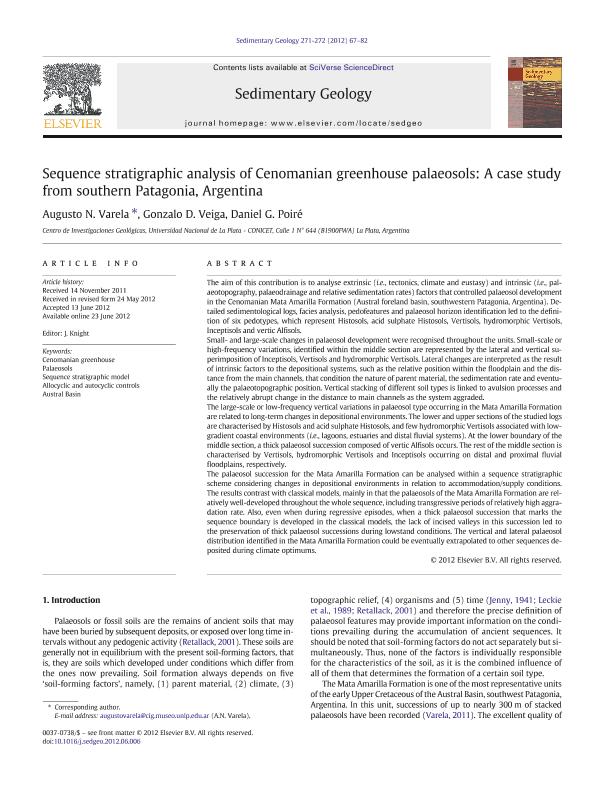Mostrar el registro sencillo del ítem
dc.contributor.author
Varela, Augusto Nicolás

dc.contributor.author
Veiga, Gonzalo Diego

dc.contributor.author
Poire, Daniel Gustavo

dc.date.available
2019-03-21T21:03:10Z
dc.date.issued
2012-10
dc.identifier.citation
Varela, Augusto Nicolás; Veiga, Gonzalo Diego; Poire, Daniel Gustavo; Sequence stratigraphic analysis of Cenomanian greenhouse palaeosols: a case study from southern Patagonia, Argentina.; Elsevier Science; Sedimentary Geology; 271-272; 10-2012; 67-82
dc.identifier.issn
0037-0738
dc.identifier.uri
http://hdl.handle.net/11336/72253
dc.description.abstract
The aim of this contribution is to analyse extrinsic (i.e., tectonics, climate and eustasy) and intrinsic (i.e., palaeotopography, palaeodrainage and relative sedimentation rates) factors that controlled palaeosol development in the Cenomanian Mata Amarilla Formation (Austral foreland basin, southwestern Patagonia, Argentina). Detailed sedimentological logs, facies analysis, pedofeatures and palaeosol horizon identification led to the definition of six pedotypes, which represent Histosols, acid sulphate Histosols, Vertisols, hydromorphic Vertisols, Inceptisols and vertic Alfisols.Small- and large-scale changes in palaeosol development were recognised throughout the units. Small-scale or high-frequency variations, identified within the middle section are represented by the lateral and vertical superimposition of Inceptisols, Vertisols and hydromorphic Vertisols. Lateral changes are interpreted as the result of intrinsic factors to the depositional systems, such as the relative position within the floodplain and the distance from the main channels, that condition the nature of parent material, the sedimentation rate and eventually the palaeotopographic position. Vertical stacking of different soil types is linked to avulsion processes and the relatively abrupt change in the distance to main channels as the system aggraded. The large-scale or low-frequency vertical variations in palaeosol type occurring in the Mata Amarilla Formation are related to long-term changes in depositional environments. The lower and upper sections of the studied logs are characterised by Histosols and acid sulphate Histosols, and few hydromorphic Vertisols associated with low-gradient coastal environments (i.e., lagoons, estuaries and distal fluvial systems). At the lower boundary of the middle section, a thick palaeosol succession composed of vertic Alfisols occurs. The rest of the middle section is characterised by Vertisols, hydromorphic Vertisols and Inceptisols occurring on distal and proximal fluvial floodplains, respectively. The palaeosol succession for the Mata Amarilla Formation can be analysed within a sequence stratigraphic scheme considering changes in depositional environments in relation to accommodation/supply conditions. The results contrast with classical models, mainly in that the palaeosols of the Mata Amarilla Formation are relatively well-developed throughout the whole sequence, including transgressive periods of relatively high aggradation rate. Also, even when during regressive episodes, when a thick palaeosol succession that marks the sequence boundary is developed in the classical models, the lack of incised valleys in this succession led to the preservation of thick palaeosol successions during lowstand conditions. The vertical and lateral palaeosol distribution identified in the Mata Amarilla Formation could be eventually extrapolated to other sequences deposited during climate optimums. © 2012 Elsevier B.V.
dc.format
application/pdf
dc.language.iso
eng
dc.publisher
Elsevier Science

dc.rights
info:eu-repo/semantics/openAccess
dc.rights.uri
https://creativecommons.org/licenses/by-nc-sa/2.5/ar/
dc.subject
Allocyclic And Autocyclic Controls
dc.subject
Austral Basin
dc.subject
Cenomanian Greenhouse
dc.subject
Palaeosols
dc.subject
Sequence Stratigraphic Model
dc.subject.classification
Meteorología y Ciencias Atmosféricas

dc.subject.classification
Ciencias de la Tierra y relacionadas con el Medio Ambiente

dc.subject.classification
CIENCIAS NATURALES Y EXACTAS

dc.title
Sequence stratigraphic analysis of Cenomanian greenhouse palaeosols: a case study from southern Patagonia, Argentina.
dc.type
info:eu-repo/semantics/article
dc.type
info:ar-repo/semantics/artículo
dc.type
info:eu-repo/semantics/publishedVersion
dc.date.updated
2019-03-18T14:12:29Z
dc.journal.volume
271-272
dc.journal.pagination
67-82
dc.journal.pais
Países Bajos

dc.journal.ciudad
Amsterdam
dc.description.fil
Fil: Varela, Augusto Nicolás. Consejo Nacional de Investigaciones Científicas y Técnicas. Centro Científico Tecnológico Conicet - La Plata. Centro de Investigaciones Geológicas. Universidad Nacional de La Plata. Facultad de Ciencias Naturales y Museo. Centro de Investigaciones Geológicas; Argentina
dc.description.fil
Fil: Veiga, Gonzalo Diego. Consejo Nacional de Investigaciones Científicas y Técnicas. Centro Científico Tecnológico Conicet - La Plata. Centro de Investigaciones Geológicas. Universidad Nacional de La Plata. Facultad de Ciencias Naturales y Museo. Centro de Investigaciones Geológicas; Argentina
dc.description.fil
Fil: Poire, Daniel Gustavo. Consejo Nacional de Investigaciones Científicas y Técnicas. Centro Científico Tecnológico Conicet - La Plata. Centro de Investigaciones Geológicas. Universidad Nacional de La Plata. Facultad de Ciencias Naturales y Museo. Centro de Investigaciones Geológicas; Argentina
dc.journal.title
Sedimentary Geology

dc.relation.alternativeid
info:eu-repo/semantics/altIdentifier/doi/https://dx.doi.org/10.1016/j.sedgeo.2012.06.006
dc.relation.alternativeid
info:eu-repo/semantics/altIdentifier/url/https://www.sciencedirect.com/science/article/pii/S0037073812001650
Archivos asociados
